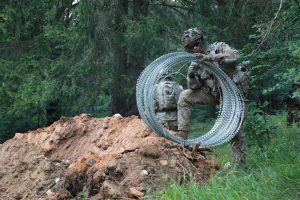After Veterans Day – Leadership in Transition

Every year, more than 80,000 Soldiers separate from the Army and become veterans. Some are superstars, some are not. Some served three years, while others are well past twenty. Some served in combat, others never deployed. However, they all have a few things in common. They volunteered to serve. They were part of our team. They will return to society as veterans. But a sad reality is that they often struggle in building a career and identity after the military and are terribly lost to suicide at rates nearly 3x higher than their peers that never served. Despite progress, we are getting transition wrong. Leaders, especially junior officers, can do more to prepare Soldiers for their transition and life beyond the military as veterans.
Like most leaders, I unwittingly contributed to this problem over a 30-year career. For all the hours consumed planning training or deploying, you could count on one hand the number of minutes I spent each day honestly worrying about what would happen to my Soldiers after they left the Army. It just wasn’t what we did. Of course I cared, but I rarely took any tangible action to ensure they were going to succeed in their post-military life. That is what the Transition Assistance Program, or TAP, was for. And helping them prepare for transition didn’t impact much of what I did as a leader, so it was largely overlooked.
Having worked in the military transition space for the last few years and reflected on my time in service, I observe two reasons why leaders don’t focus as much as they should on helping Soldiers transition
Transition is Not a Priority
First, junior officers are really busy. There are too many things on their plate. Understanding that building readiness in the formation is their primary responsibility, it is no surprise that hours are spent on maintenance, on the range, or in the field. When you add up all the things that a junior leader must do, the things that will probably have an impact on a successful career, it shouldn’t surprise anyone that what gets lost are the things they should do.
The very best officers find time to balance the musts with the shoulds. They care just as much about knowing their Soldiers as individuals as they do about their PT scores. They do regular counseling, and they actually listen to their people. They know their families. They bring out the best in their team. They do these things because they are right and because they truly care. And caring for Soldiers shouldn’t stop just because they are transitioning.
Organizational Metrics are Short-term
The second problem is institutional. Our leaders are not incentivized to care about transition. Consider what happens to a Company Commander if they lose a sensitive item on a field problem, or their operational readiness rate falls into the low 70% range, or they have too many dental CAT 4s. Now imagine what happens to that very same officer if the next 10 Soldiers that separate from the formation are homeless, unemployed or underemployed, or struggle mentally after leaving the military. In the first instance, it isn’t good. In the second, the answer is ‘nothing.’
In 2011, Congress passed legislation that established a formal program for Soldiers transitioning from active duty. The TAP program is a requirement for all transitioning servicemembers. Over the years, unfortunately, spending time on transition programs came to be viewed as ‘somebody else’s job’ at best, and ‘encouraging people to get out’ at worst. Both are wrong. Leaders should be encouraging Soldiers to think about transition routinely and should engage with them as they go through the process. It is the one thing that all of them, and all of us, are going to do. Helping them get this process right is every bit as important as the other tasks we manage day to day.
Helping Soldiers as they transition doesn’t mean we are pushing good people to leave. Part of the problem with today’s transitioning Soldiers is that many are not actually prepared for life after the military. They haven’t built up the experiences, education, and credentials that will make them competitive in the civilian world. Some are not emotionally ready for civilian life. There is no better place to build the foundation for a successful future than in the Army and there are countless resources available to do just that. It is the Leader’s responsibility to ensure their Soldiers are informed and set up for success.
Actions Juniors Officers Can Take
As front-line leaders who see Soldiers daily, there are many things junior officers can do to address this issue:
Have honest conversations with your Soldiers. That includes discussing if it makes sense to reenlist or potentially makes sense to exit service, so long as it is accompanied by a set of goals that will set them up for future success. Also, ask them open-ended questions about their plans and expect specific answers. Simply engaging with them about their future demonstrates a genuine investment in them as people. It also forces them to think more deeply about the specifics of a monumental life change. It is both a should and a must.
Understand and explain the benefits they earned by virtue of their service. This information will be presented during TAP, but only very briefly and often too late in the transition process to be of use. Help them get the basics right. Ensure your Soldiers document every injury, request their medical records a year out from separation, and file a pre-discharge disability claim. Educate them on the requirements for enrolling in College, or the opportunities presented in credentialing programs. Again, there are many benefits and programs, such as the G.I. Bill and the Yellow Ribbon scholarship, that provide tremendous financial incentives to Soldiers that too few know about when exiting service. Misinformation and naivety about benefit programs prevents far too many from making the most of their opportunities, whether in service or after.
Connect them to people and resources that can help them. Officers often have built in networks and are very good at seeking other officers who have already transitioned to graduate schools or the public or private sector. However, Soldiers are often younger and sometimes lack that network and mentorship. Consider connecting your Soldiers to others who have made a successful transition to college, trade school, or the private sector. Also, consider connecting them to reputable Veterans Service Organizations, non-profits, and veteran-focused groups who can help them in their communities.
Finally, encourage them to ask for help when they need it. For too many, simply acknowledging they have questions or challenges in their personal lives is viewed as a sign of weakness. Soldiers must trust us enough to open up, and that trust is earned by our actions. So try to build a culture in your organization that enables Soldiers to speak up and ask for help.
Why it Matters
A focus on transition not only builds a better force today, but it contributes to a stronger Army tomorrow. There is no better recruiter than a successful Army Veteran. As leaders, we care about our Soldiers and that should not change when they submit their ETS packet and begin their transition from military to civilian life. It is yet another opportunity for their leadership to take care of their Soldiers. Junior officers have an enduring responsibility to their Soldiers that lasts long beyond thanking them for their service on the 11th of November.
Author Biography
Brigadier General (ret) Mike Eastman serves as the Executive Director of the Onward Ops military transition support program. A 1991 graduate of USMA, his assignments included Deputy Commanding General, 10th Mountain Division and Commanding General, Train, Advise and Assist Command-South, Kandahar, Afghanistan.
Related Posts

Going Off Script, But Staying on Track: A Career Guide for Junior Leaders
Intro I walked into LTC Tomi King’s office as a new 2LT in his formation. We discussed all the normal talking points in that initial counseling – family, where I …

Fighting as an Enabler Leader
(U.S. Army Photo by Cpl. Tomarius Roberts, courtesy of DVIDS)Enablers provide capabilities to commanders that they either do not have on their own or do not have in sufficient quantity …

Defeating the Drone – From JMRC’s “Skynet Platoon”
If you can be seen, you can be killed—and a $7 drone might be all it takes. JMRC’s Skynet Platoon discuss their TTPs to defeat the drone.
